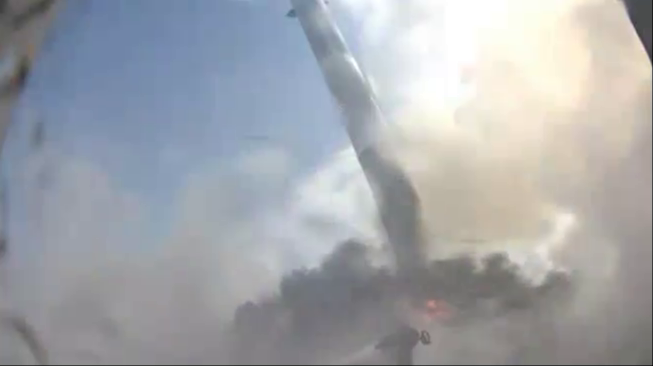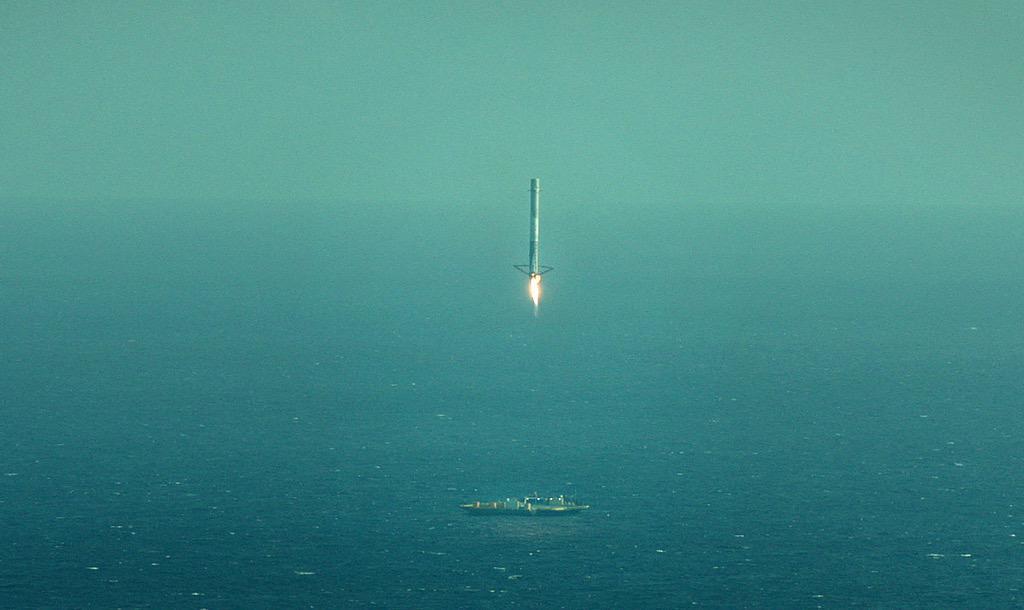Video and details of the failed landing Falcon-9R
Just read the Instructions https://t.co/4Te0BfT2Qn
- SpaceX (@SpaceX) April 15, 2015Landing the first stage of the Falcon 9 on the ship “Just read the instructions” (Just Read the Instructions), aerial view. The moment of the fall is not shown. Updated 2015-04-16 01:15: SpaceX has published a more complete and better version of this video .
After the postponement, SpaceX successfully launched the Dragon truck to the International Space Station. The ship was separated from the second stage, the solar panels were opened and, most likely, it will dock with the ISS in two days. On board, almost two tons of cargo - food, equipment, scientific experiments. But the execution of the second task of this launch again failed.

An infographic on the process of landing the first stage of the Falcon 9. Large image is available by clicking.
As Ilon Musk himself said , the chances of a successful outcome were less than 50%. In total, due to the large number of launches, the probability of at least one successful landing this year is 80%. The process consists of the following steps:
')
- Launching a two-stage Falcon 9 rocket from the launch pad. The rocket engines are turned on and it comes off the Earth, gaining altitude and speed.
- Termination of work of all nine engines of the first step and its branch.
- Turn the first stage and re-enable the engine to dampen the speed. The stage has its own control and guidance system, which orients the rocket in the direction of the spaceport-ship. The device moves at a speed of about 4800 kilometers per hour.
- The engine starts again. The step is fully vertical. Four trellis rudders open to further control the flight of the rocket. The speed drops to about 900 kilometers per hour.
- The last engine start when boarding the ship is “Just read the instructions.” The stage slows down to about 8 kilometers per hour. Four aluminum and carbon fiber supports are disclosed.
- Landing on the floating platform. The service personnel, located in kilometers from the ship, reaches it, then fixes the device on the surface and eliminates any remaining fuel components.

Landing on the barge, the first frame, SpaceX
Landing the first stage almost ended in luck. The first photo shows how the step hovered above the ship, how the supports opened, the second image hints that something went wrong. Ilon Musk suggests that the landing went well, but excessive lateral speed caused the rocket to tip over.

The second image, it shows a drop, SpaceX
At the moment, besides the movie from the aircraft , only video with an extremely low frame rate is available, that is, in fact, just photos - only two of them were published. After a few days, the ship “Just read the instructions” will return to the port together with the first stage of the Falcon 9 rocket, then SpaceX service personnel will extract and publish normal videos on the Web. Up to this point, an accurate analysis of what happened will not be.
This is the third unsuccessful landing of a Falcon 9 rocket. SpaceX’s past attempts to gently land the first stage failed: in the first case , there was not enough liquid in January in the open hydraulic grid steering wheels and the paralyzed rocket fell onto the ship. In the second case , the weather in February prevented it, so it was not possible to launch a platform ship into the sea, and the automatic equipment put the first step on a surface that did not exist. The landing of the first stage of the Falcon 9 rocket will help to significantly reduce the cost of the launch, since then part of the rocket can be reused. Musk claims that fuel costs only 0.3% of the total cost of the rocket.
The new launch of Falcon 9 will take place on April 24, but the Turkmen communications satellite will be output, and its orbit parameters will exclude testing of the return of the first stage. Most likely, the next probable attempt to land the first stage will happen only on June 22, during the delivery of the next supply ship for the ISS.
Video start. Start starts at 15:45.
Now Dragon is on its way to the ISS. This is the sixth launch of this truck to the ISS (there will be 12 of them altogether) and the eighth flight as a whole. Two days after launch, the ship will be caught by a manipulator and attached to the station, and in another five weeks the capsule will land near the California coast. Dragon will return to Earth more than a ton of equipment, computer devices, scientific experiments, garbage. At the moment it is the only existing space truck that is able to return cargo to Earth - the contents of Progress burns in the atmosphere.

A few seconds before the fall, SpaceX
Source: https://habr.com/ru/post/365391/
All Articles